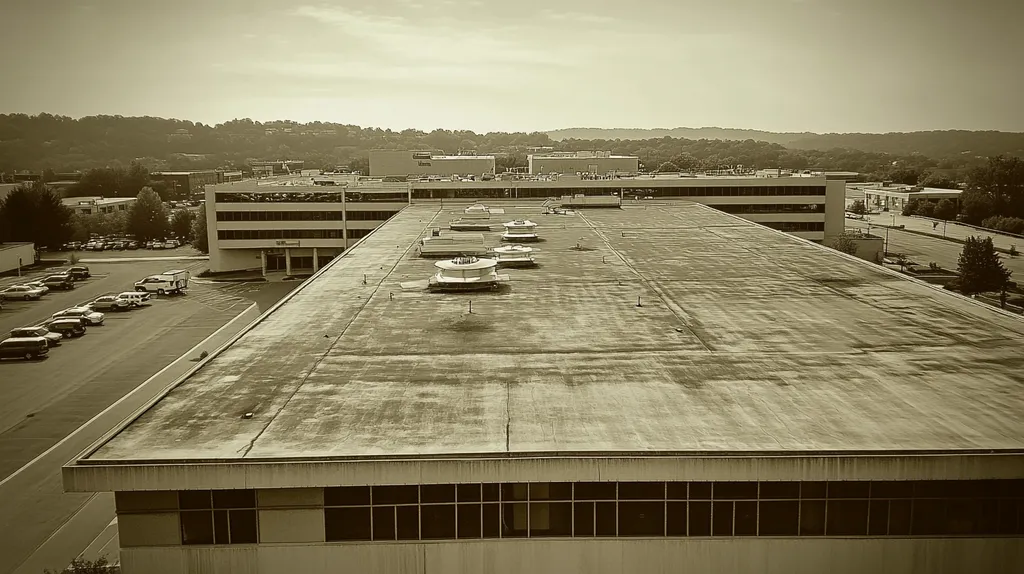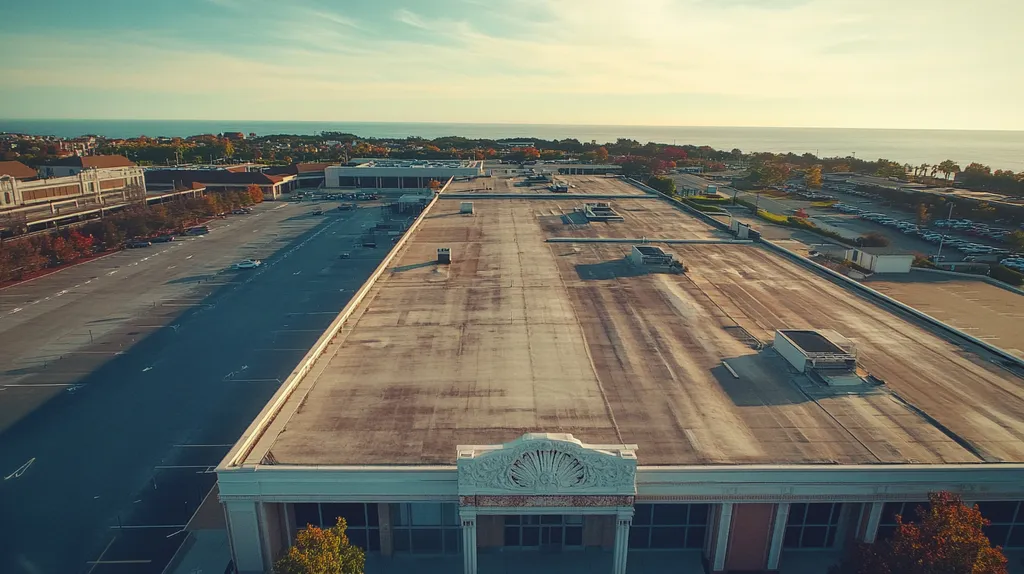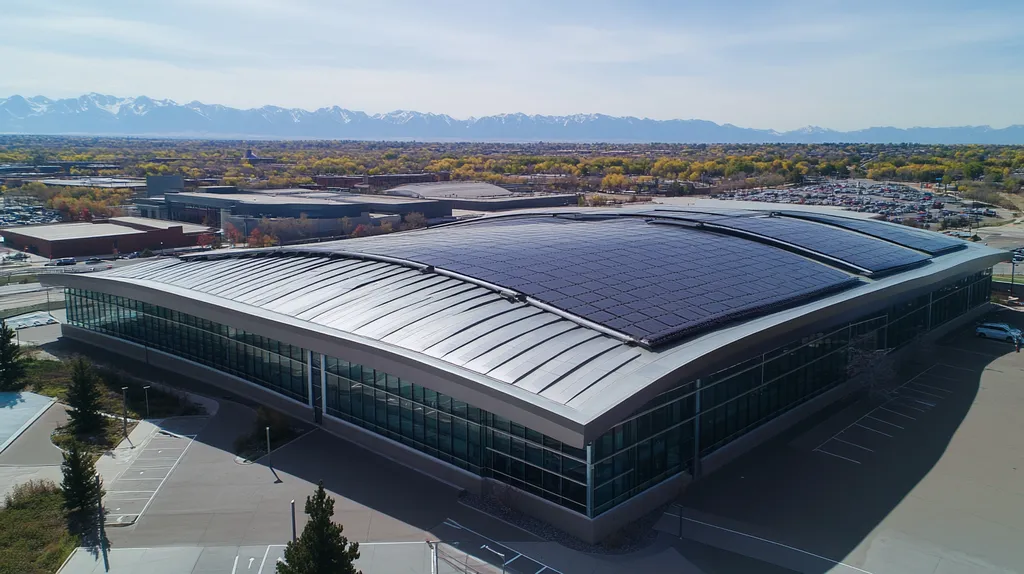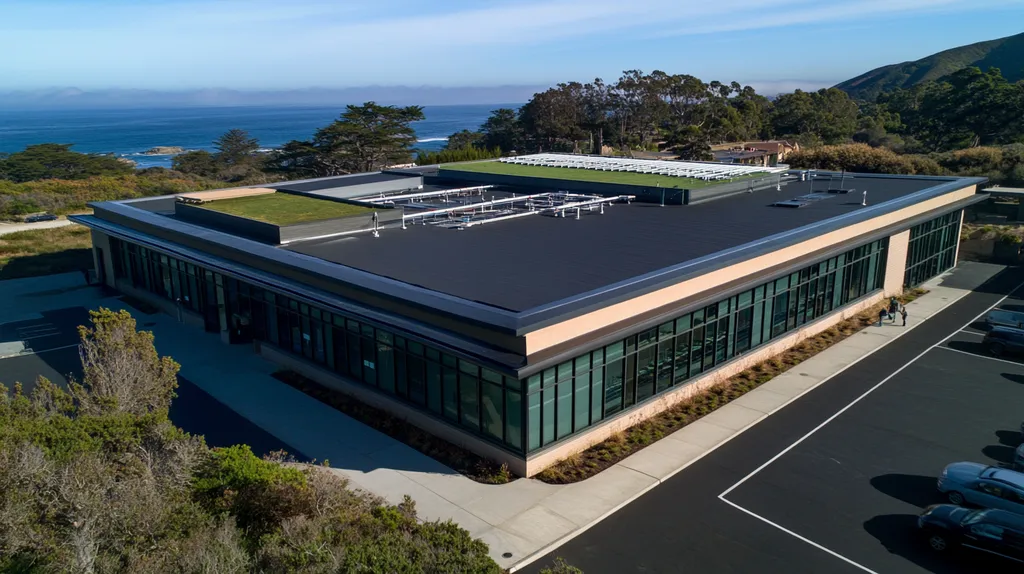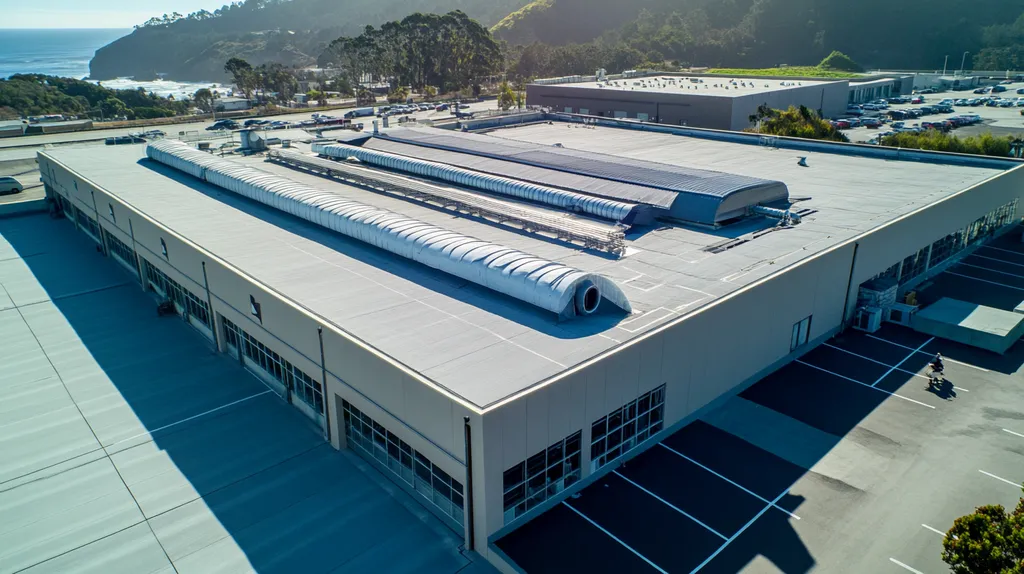Up to 40% of commercial roof warranties are compromised by weather-related damage each year, resulting in billions of dollars in uncovered repairs and premature replacements.
As extreme weather events increase in frequency and severity, understanding how climate conditions affect roofing warranties has become crucial for protecting commercial property investments.
This comprehensive guide examines the complex relationship between weather impacts and warranty coverage, providing property owners and facility managers with essential knowledge for maintaining valid protection and avoiding costly claim denials.
SECTION 1: THE BASICS EXPLAINED
Understanding how weather affects commercial roof warranties is vital for protecting a business’s investment. Commercial roofs endure extreme conditions such as heavy rainfall, soaring temperatures, and powerful winds. Research indicates that a significant portion of roof failures is due to weather-related damages, highlighting the necessity for careful warranty considerations. This section will clarify what warranties entail, explain why weather influences them, and offer guidance for property owners navigating these complexities.
What It Is (In Plain Language)
A commercial roof warranty serves as a guarantee from the manufacturer or contractor, promising to cover defects and failures under certain conditions. Typically, warranties focus on material quality and workmanship but are also susceptible to environmental factors, particularly weather events.
Common warranty types include material warranties from manufacturers and workmanship warranties from installers. These documents specify what is covered and for how long. It is crucial to scrutinize the fine print, as harsh weather conditions may void some warranties.
For instance, a typical warranty may cover leaks while excluding damage from hail or strong winds, emphasizing the need to understand both inclusions and exclusions for effective claim submissions.
The more knowledgeable a property owner is about their warranty’s terms, the better equipped they will be to handle weather-related challenges.
Why It Matters (To Your Building)
Weather significantly influences the longevity and integrity of commercial roofs. Acknowledging this impact highlights the importance of selecting a suitable warranty. Without adequate protection against weather-related threats, roofs may face structural damage that results in expensive repairs.
For example, heavy snowfall can lead to roof collapse if warranties do not adequately address this issue. Additionally, fluctuations in temperature can cause materials to expand and contract, leading to premature degradation. Neglecting these factors could result in severe financial repercussions.
Furthermore, local climate conditions should inform warranty choices. A structure in a flood-prone region will require a different warranty strategy than one in an arid area. Tailoring warranty coverage to account for environmental factors can mitigate future risks.
A solid grasp of how weather impacts roofing warranties enables smarter decision-making, protecting financial investments and extending the life of roofs.
How It Works
Roof warranties operate like contracts, with specific terms outlining what weather-related damages are covered. Generally, warranties delineate the circumstances under which they remain valid, distinguishing between “normal” and “extraordinary” weather events.
For example, a standard warranty might cover leaks if wind gusts exceed a specified speed. However, damage from severe hurricanes or tornadoes might fall outside of coverage, potentially leading to rejected claims. Understanding these parameters is crucial for avoiding unexpected costs.
Moreover, routine maintenance is often necessary for warranties to stay valid. A well-maintained roof is less vulnerable to failure from weather-related issues, and regular inspections can identify potential weaknesses. This proactive strategy helps maintain warranty protection against weather-related claims.
Ultimately, property owners should collaborate with roofing professionals to review warranties and address weather impacts, ensuring a thorough understanding of how all components function for effective roof management.
SECTION 2: PRACTICAL APPLICATIONS
Recognizing the weather’s impact on commercial roof warranties is fundamental for property owners and facility managers. Adverse weather can inflict serious damage, potentially nullifying warranties and exposing businesses to unforeseen costs. For example, hail damage from a storm might go uncovered if an improper inspection was conducted prior to installation. This section delves into typical scenarios, highlights critical timing, and examines how weather interacts with other roofing systems.
Common Uses & Examples
Understanding how weather-reliant warranty clauses function is essential across multiple scenarios. For instance, a flat roof exposed to heavy rainfall may develop leaks if conditions were not accurately documented before installation. If such details are overlooked, claims can be denied, leaving property owners to bear repair costs.
Wind uplift during storms poses another risk, threatening the integrity of roofing membranes. Employing appropriate installation methods that consider local wind patterns is crucial in ensuring the warranty remains valid.
Awareness of these applications allows for the development of proactive maintenance strategies, ensuring that property owners are prepared to address adverse weather conditions when they arise.
When You Need It Most
Specific seasons present increased risks to roofing systems, making a deep understanding of warranty conditions critical. For example, winter poses a heightened threat as snow accumulation can lead to structural failure if roofs are not designed to support such loads. Many warranties require regular inspections during these peak seasons to preserve coverage.
Additionally, following significant weather events, like hurricanes, timely documentation of any damage is vital. Failing to promptly inspect or report issues may jeopardize warranty claims, as these often come with time-sensitive provisions.
Being aware of these essential periods empowers property owners to act swiftly, ultimately shielding their investments from potentially substantial losses.
Interactions With Other Systems
Weather impacts are interconnected with other building systems, influencing the overall performance of the roofing structure. For example, drainage systems must be optimized to manage heavy rainfall effectively. A clogged gutter can cause water to pool, heightening the risk of roof damage and jeopardizing warranty validity.
Furthermore, HVAC systems may contribute to condensation that can harm roofing membranes if not insulated correctly. Neglecting these interdependencies can lead to additional expenses and diminish the effectiveness of warranty protections.
Thus, integrated planning is essential to ensure that roofs, drainage systems, and HVAC units function cohesively, thus safeguarding the overall structure from the adverse effects of weather.
SECTION 3: KEY TERMINOLOGY DECODED
Grasping the terminology surrounding commercial roof warranties is vital for property owners and facility managers. Misinterpretations can lead to inadequate maintenance and hefty repairs. Alarmingly, nearly 30% of commercial roofs fail prematurely due to issues related to adverse weather, often intensified by gaps in warranty coverage. This section aims to clarify essential terms, demystify industry jargon, and break down measurement standards, empowering informed decision-making.
Essential Terms Explained
Warranties act as a safety net for property owners, but they come with defined conditions. A “material warranty” covers defects in roofing materials, while a “workmanship warranty” pertains to installation errors. Each type is crucial for ensuring the longevity and effectiveness of a roof.
Weather conditions play a significant role in warranty provisions. For instance, hail damage might be included in some warranties but not in others, depending on the specific terms. Therefore, it is vital to read the fine print to know what is covered and what could void the warranty.
Key terms like “maximum wind speed” and “puncture resistance” are critical in assessing a roof’s defense against severe weather. Understanding these metrics enables property owners to evaluate local weather risks accurately.
Familiarity with these fundamental terms equips property owners to advocate effectively for their roofs. This ensures they select the most appropriate materials and comprehend the warranties that safeguard their investments.
Industry Jargon Translated
The roofing industry is filled with specialized terms that can create confusion for property owners. For example, “TPO” stands for Thermoplastic Olefin, a widely used roofing material praised for its energy efficiency. Knowing about these materials allows for informed choices based on specific climate and cost factors.
Another common term is “flashing,” which refers to materials installed to prevent water infiltration at joints and roof edges. Proper installation of flashing is crucial; without it, warranty claims may be denied.
Understanding phrases like “drainage slope” and “R-value” is also essential. The drainage slope prevents water pooling on the roof, while R-value indicates a material’s insulation effectiveness against heat loss.
By breaking down the industry’s jargon, property owners can communicate clearly with roofing professionals, leading to improved project outcomes and stronger warranty protection.
Measurement & Units Simplified
Various measurements in commercial roofing can seem daunting. A fundamental understanding of square footage is essential, as most roofing materials are sold by the “square,” covering 100 square feet. This knowledge assists in budgeting and material selection.
Temperature ratings for roofing materials often determine their compatibility with specific climates. For example, knowing the “low-temperature performance” of materials is vital in colder regions to prevent undue failure during severe weather.
Another crucial measurement is “gauge,” which indicates the thickness of metal roofing materials. A lower gauge number signifies a thicker and more durable material, significantly affecting warranty coverage and roof lifespan.
By simplifying these measurements and units, property owners can make more informed choices regarding materials and understand their implications for both warranty coverage and weather resilience.
SECTION 4: DECISION FACTORS
Choosing the right commercial roofing system is a critical decision that significantly impacts a property’s longevity and operational costs. Weather plays a pivotal role in roofing performance and must be considered alongside cost, durability, and overall effectiveness. Property owners and facility managers face numerous factors that can affect not only the warranty of the roofing system but also the long-term health of their investment. An informed approach to these decision factors is essential for adapting to environmental challenges.
Cost Considerations
Cost remains a central concern when selecting a roofing system, but initial expenses may not tell the complete story. Low-cost materials can appear attractive at first glance but often fail to meet warranty requirements when subjected to extreme weather conditions. For instance, an inexpensive membrane might offer short-term savings but could incur costly repairs or replacements if it proves unable to withstand heavy rainfall or snowfall.
Furthermore, opting for higher-quality materials typically means receiving extended warranty protection. Roofing systems designed to endure severe weather are often accompanied by more robust guarantees, reducing financial risks in the future. Property owners should evaluate the total cost of ownership, considering both potential repair expenses and initial savings.
Additionally, the choice of less durable roofing can have implications for insurance costs. If a roofing system performs poorly during extreme weather, it may lead to increased premiums or denied claims, further straining budgets. Investing wisely upfront can lead to significant long-term savings.
To make the most informed choices, constant evaluation of cost versus performance is essential for property owners navigating the complexities of commercial roofing.
Performance Trade-offs
Understanding performance trade-offs is vital for making sound roofing decisions. Local weather challenges can dictate the specific performance requirements for roofing materials. For example, roofs in hurricane-prone regions must adhere to stricter wind resistance standards to remain effective.
Durable roofing may call for advanced materials designed to handle issues such as thermal expansion and moisture intrusion effectively. Under severe weather, the performance of roofing materials often determines whether warranty claims will be honored. If an inferior product fails during extreme conditions, the warranty may be voided due to inappropriate material selection.
Moreover, selecting the correct insulation and moisture barriers can significantly enhance roof performance. Effective insulation regulates internal temperatures and boosts energy efficiency. Although some trade-offs might seem appealing for immediate cost reductions, they can compromise long-term performance and lead to premature system failures.
A thoughtful evaluation of the balance between performance capabilities and initial costs is critical for ensuring a successful roofing investment.
Lifespan & Durability Factors
The expected lifespan and durability of a roofing system play a crucial role in decision-making. A long-lasting roof often provides a better return on investment compared to cheaper, less resilient options. For instance, a high-quality thermoplastic polyolefin (TPO) roof can last over 20 years, while lower-grade alternatives may not endure beyond a decade.
Local weather conditions, including temperature extremes and exposure to precipitation, heavily influence a roof’s durability. Materials specifically rated for intense durability are better equipped to withstand harsh climates, affecting both longevity and maintenance costs. Roofs designed for enhanced weather resistance extend warranty coverage and improve operational reliability.
Routine inspections and maintenance are vital in maximizing the lifespan of a roofing system. Proactive upkeep can thwart minor issues from developing into significant problems, ensuring warranty protection remains intact. Emphasizing consistent maintenance underscores its importance in prolonging a roof’s service life while securing the investment.
In summary, assessing lifespan and durability helps property owners make informed decisions that align with long-term objectives and the realities of local weather conditions.
SECTION 5: COMMON CHALLENGES
Navigating the intricacies of commercial roofing warranties is essential, especially in an era marked by unpredictable weather patterns. Extreme conditions, such as heavy storms and unseasonable temperature fluctuations, can jeopardize roof integrity and warranty coverage. Property owners need to stay alert to common roofing challenges to protect themselves from substantial repair costs and potential warranty voids.
Frequent Problems & Solutions
Many issues arising on commercial roofs stem from insufficient maintenance and unexpected weather impacts. For example, ponding water can create severe structural risks if not addressed promptly. If roof membranes are compromised, it could lead to leaks that may not be covered by warranties.
Regular inspections are a proactive solution to catch these problems early. Hiring a professional roofing contractor for seasonal check-ups is advisable, as this practice can include debris removal, seam inspections, and ensuring optimal drainage.
Establishing strong lines of communication with roofing providers is also crucial. Understanding warranty specifics and available repair options can significantly enhance long-term maintenance strategies. Clarity on warranty terms helps guide informed decisions regarding repairs and modifications.
Warning Signs To Watch For
Early identification of warning signs can save property owners significant expenses over time. Common indicators to observe include visible water stains on ceilings, cracks in roofing materials, and peeling paint. Each of these symptoms suggests moisture intrusion, which may compromise the roof’s integrity.
Loss of granules from shingles on sloped roofs can present another major concern. These granules protect underlying materials from UV rays; their absence can lead to severe damage and potential disputes over warranty coverage.
Moreover, damage to flashing—often overlooked—can create substantial problems. Broken or bent flashing may allow water to penetrate vulnerable areas, compounding risks. Routine vigilance can help prevent costly repairs and bolster warranty validity.
Preventative Approaches
Implementing preventative measures is vital for protecting roofing investments and ensuring warranty validity. Establishing a routine maintenance schedule is essential. Maintaining a calendar for inspections alongside weather event follow-ups guarantees roofing systems stay in peak condition.
Investing in high-quality materials and installation practices is another practical approach. While cheaper alternatives may seem appealing, they often lead to higher expenses over time due to frequent failures. Selecting reputable contractors committed to industry best practices can mitigate long-term risks.
Lastly, enhancing staff education regarding the effects of weather on roof performance is critical. Providing workshops and training sessions equips facility managers with the knowledge to identify issues early, enabling timely interventions. By fostering this culture of awareness, property owners can safeguard their investments effectively.
SECTION 6: NEXT STEPS & RESOURCES
Grasping the complexities of commercial roof warranties is crucial, especially since weather-related damage can compromise coverage. Research indicates that over 70% of roofing claims are denied due to noncompliance with warranty specifications. Property owners and facility managers need to ask pertinent questions and utilize reliable resources to safeguard their investments and enhance the lifespan of their roofs.
Questions To Ask Providers
Property owners should adopt a proactive approach when consulting roofing providers. Start by asking about specific weather conditions that could nullify warranty coverage. For example, understanding the manufacturer’s obligations for notifying them of storm damage can clarify responsibilities upfront.
Next, inquire about the testing methods used to assess how the roofing materials will perform against local climate challenges. This knowledge can help gauge the roof’s resilience to extreme weather.
Maintenance recommendations are also crucial. Many warranties require adherence to a schedule for regular maintenance; understanding these stipulations is essential for keeping the warranty valid.
Finally, it’s important to establish whether the warranty is transferable in the event of a property sale. Knowing these details can help future owners avoid unexpected expenses.
Industry Standards & Guidelines
Adhering to industry standards is vital for protecting long-term investments in commercial roofing. Organizations like the National Roofing Contractors Association (NRCA) offer guidance on best installation practices and warranty specifics, ensuring compliance with necessary terms.
Moreover, getting familiar with product-specific manuals from manufacturers is key. These handbooks outline critical information about coverage and limitations, helping prevent potential misunderstandings.
Regularly reviewing established standards further educates property owners about evolving best practices, which can mitigate risks related to storm damage and warranty claims.
Staying updated with current studies on weather impact will also enhance understanding of material behavior under various conditions, aiding in strategic roofing choices.
Further Learning Simplified
Ongoing education is essential for property owners and facility managers when it comes to roofing warranties. Online webinars focusing on commercial roofing intricacies can be invaluable. Many industry organizations offer interactive sessions based on real-world scenarios, enriching understanding.
Reading specialized industry publications can also provide significant insights. Articles that discuss warranty challenges in the context of climate change and extreme weather can enhance knowledge in protecting assets.
Joining professional associations introduces property owners to a network of experts, offering an excellent resource for advice on specific warranty issues.
Finally, tapping into online resources such as blogs and forums, where roofing professionals exchange experiences, can yield practical strategies for navigating warranty concerns. Being proactive in acquiring knowledge can greatly improve decision-making.
The Bottom Line
With weather-related roof damage causing over $1.5 billion in annual losses for commercial properties, understanding warranty implications has never been more critical.
Climate change continues to amplify extreme weather events, making comprehensive warranty protection essential for safeguarding substantial roofing investments.
Property owners must carefully evaluate warranty terms regarding weather impacts, ensure proper documentation of maintenance activities, and maintain clear communication with providers.
Regular inspections, adherence to manufacturer specifications, and prompt response to weather events remain fundamental to preserving warranty validity.
As weather patterns become increasingly unpredictable, the difference between protected and unprotected commercial roofs often lies in understanding and properly maintaining warranty coverage.
FREQUENTLY ASKED QUESTIONS
Q. How does weather affect commercial roof warranties?
A. Weather impacts commercial roof warranties by determining coverage for specific damage types. Certain warranties may exclude events like hail or severe wind, leading to denied claims. Understanding these limitations is essential to protect your investment from unforeseen weather-related failures.
Q. What should I know about common weather-related damage to industrial roofs?
A. Common weather-related damages include leaks from heavy rain and structural failures due to snow accumulation. Understanding these risks allows property owners to implement preventive measures and ensure their warranties cover potential weather impacts, ultimately prolonging roof lifespan.
Q. What key terminology should I understand regarding commercial roof warranties?
A. Key terms to understand include “material warranty” covering materials and “workmanship warranty” covering installation. Familiarity with terms like “maximum wind speed” and “puncture resistance” enables informed decisions, ensuring your roofing system withstands local weather conditions while maintaining warranty validity.
Q. How can I choose the right commercial roof based on weather factors?
A. Evaluating local weather conditions is crucial when selecting a roofing system. Consider factors such as typical precipitation, wind patterns, and temperature fluctuations. Opting for materials designed for local climate extremes helps ensure the roof’s durability and compliance with warranty requirements, protecting your investment.
Q. What are common challenges with commercial roof warranties?
A. Frequent challenges include warranty exclusions for weather-related damages and inadequate maintenance leading to claim denials. Property owners must conduct regular inspections and understand warranty specifications to avoid costly repairs resulting from missed compliance with terms imposed by the warranty.
Q. What should I ask roofing providers about warranties?
A. Inquire about weather-related conditions that could void warranties, testing methods for materials against local challenges, and maintenance requirements necessary for warranty validity. Understanding these details enhances informed decision-making and helps avoid future unexpected expenses related to damages.
Q. How can I improve my knowledge about roofing warranties?
A. Ongoing education can include attending webinars on commercial roofing, reading industry publications, and joining professional associations. Engaging with online resources like blogs and forums where experts share insights can also enhance understanding of warranty intricacies, ultimately leading to better asset protection.

